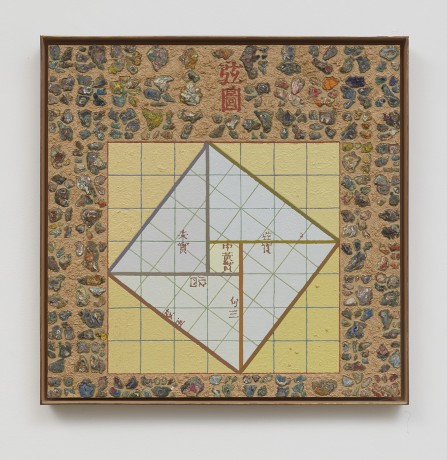
For those of us with a soft spot for practical effects movies and guitar solos, the confluence of technique & material so unexpectedly encountered as to render novelty or discourse irrelevant to the virtuosity before you, Tibor de Nagy’s latest Jess (1923—2004) retrospective, Piling Up The Rectangles, is a total thrill. Their seventh solo showing of the Beat-era artist after nearly ten years and their first to confidently combine Collins’s painstakingly-crafted collages and paste-ups with his oracularly touched oil paintings, it showcases a breadth of techniques and densities that aren’t just aesthetically bonkers but genuinely get at why we’re so enraptured by art in the first place.
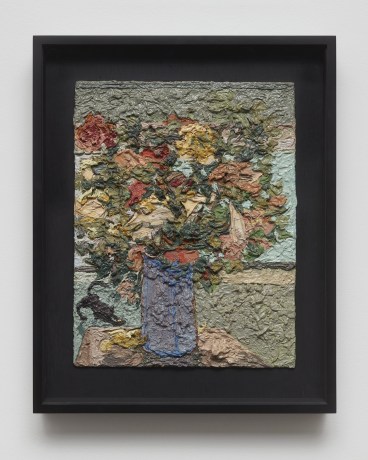
In the mid-1990s, I began visiting the reclusive artist Jess in the Victorian house in San Francisco’s Mission district that he shared with the poet Robert Duncan. During one of my first visits, Jess showed me two things that I have never forgotten. In a closet in the crowded but orderly parlor room, he showed me completed jigsaw puzzles that he had carefully stacked. The stack was at least six feet high, and each puzzle was identified by a note. That afternoon he also showed me his flat files, drawers full of carefully labeled envelopes holding images he had cut out and classified for his intricate “paste-ups,” which is what he called his collages. Each paste-up was composed of images — sometimes hundreds — from a wide range of sources.
Penny Stamps Lecture Series at University of Michigan Museum of Art
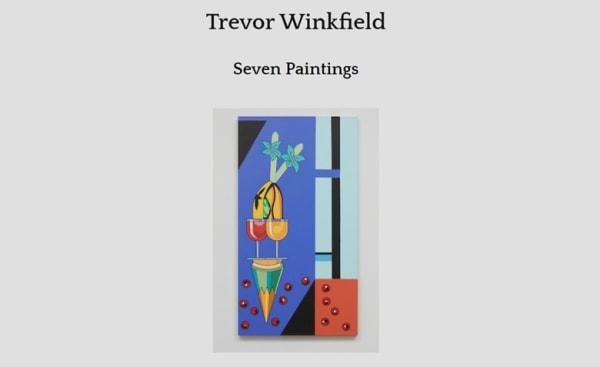
Around forty years ago, a gallery owner paid a visit to my studio and after studying my paintings for a while observed, “I like your paintings but I don’t know where I am in them.” That was the last I saw of him, but I took his comment as a compliment, not a rebuke. I now take it as a given that there is no ideal entry point into my paintings, nor do they have a single meaning. Early on I took to heart Marcel Duchamp’s dictum, “It’s the spectator who completes the work of art”: your interpretation is as valid as my own, an offer which should not be mistaken for indecision.
All images reproduced courtesy of the Artist and Tibor de Nagy Gallery, New York.
Link here
THE NEW SOCIAL ENVIRONMENT #944
Sarah McEneaney: The World Around
Featuring McEneaney and Amanda Millet-Sorsa, with Rachel James
Link Here
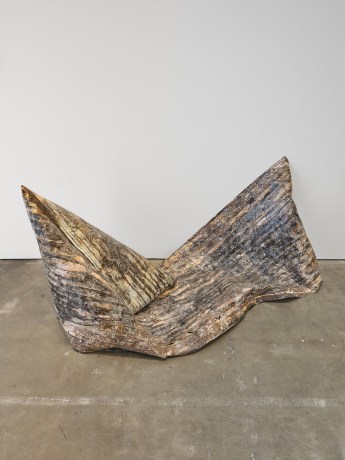
Joy Episalla / Suzanne Silver / Sivan Silver-Swartz
Curated by Margaret Tedesco
September 16, 2023 through March 23, 2024
More info here
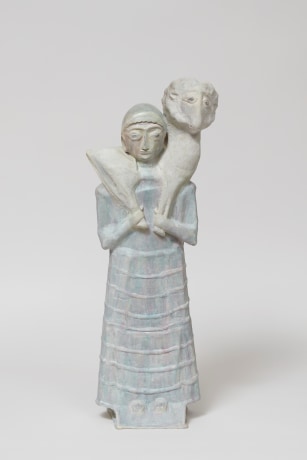
The ghostliness continues next door at Tibor de Nagy, who just opened Shari Mendelson’s Chasing the Deer, a series of small artifact-like sculptures cast in mineral shades one might consider off-white, light light-blue, light light-green, and pale gold. In her just-released memoir Everything/Nothing/Someone, Alice Carrière speaks about extremely thin drinking glasses that her mother, painter Jennifer Bartlett, had custom-made with the intention of being as close to nothingness as possible. A similar idea seems to be in play here with Mendelson’s sculptures, which are so light and ephemeral that they had to be glued to their pedestals with museum wax so they don’t blow over when the door opens. Mendelson draws from a disparate set of cultural references for her subject matter, including an ancient Mesopotamian cylinder seal in Chasing the Deer and an Instagram post of her friend carrying a goat in Ram Bearer (2023). Mendelson’s deft technique completely obscures the fact that all of these works are made out of regular plastic bottles, the socio-cultural and environmental implications of which are intriguing, creating a subtle interplay between ancient artifact-hood and throwaway consumer detritus.
The light is fading now, and a walk back across Sara D. Roosevelt provides a window to watch the nightly game of pick up soccer. After seeing a bunch of exciting new art, for a great evening of nearly-free entertainment, buy a couple tall cans of beer with a friend or two and watch these guys play in the evenings until it gets too dark and they start missing too many shots.
Contributor, Oliver Katz
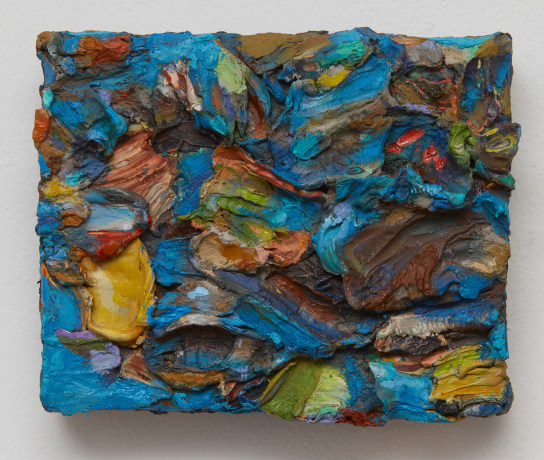
The Elders, the debut exhibition at Tibor de Nagy (April 20–May 26, 2023) of the anonymous artist new.shiver, follows on the artist’s first, largely unheralded, similarly titled exhibition, New.shiver: The Elders, at Satchel Projects (April 21–May 22, 2022). After seeing this person’s posts on Instagram, exchanging a handful of brief messages, and seeing the actual paintings at Satchel Projects and, now, Tibor de Nagy, I am taken by the artist’s patience, which is not emphasized in the work. No overt signs of labor and struggle can be discerned in the exhibition’s 20 intimately scaled works — all between 4 x 5 and 11 x 14 inches, composed of different densities of paint — which have a tangential relationship to gestural abstraction.
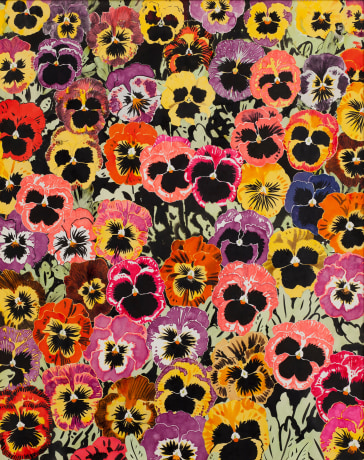
Joe Brainard: The Art of the Personal by John Yau
I remember Joe Brainard. I never met him, and when I first felt his
influence I had no idea who he was or where he came from, but the
influence went deep. It came across stealthily and through scattered
channels, apprehended in the corner of the eye, in cartoons that
appeared in The East Village Other or back issues of his own C Comics
(including an unforgettable and much-shared creation called “People
of the World: Relax!”) or covers designed for the work of poets such as
Ron Padgett and Anne Waldman or flyers for the St. Mark’s Poetry
Project.
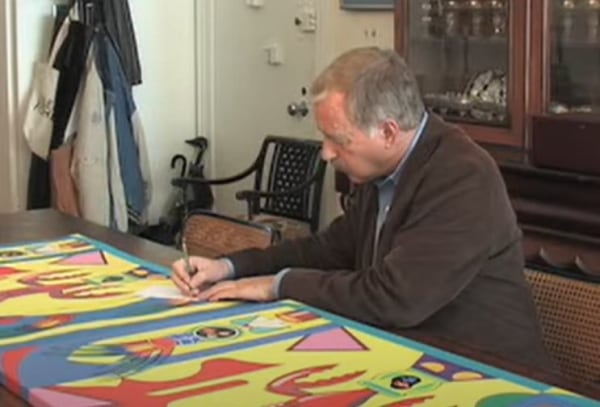
fierce pussy - Joy Episalla, Carrie Yamaoka, Zoe Leonard, Nancy Brooks Brody
Exposed curated by Francois Pinron and based on a book by Elisabeth Le Bovici Ce que le sida m'a fait - Art et activisme a la fin du XXe siecle
For the Record - part of - arms ache avid aeon: chapter 7 - conceived by Jo-ey Tang
Febrary 16 to May 14, 2023
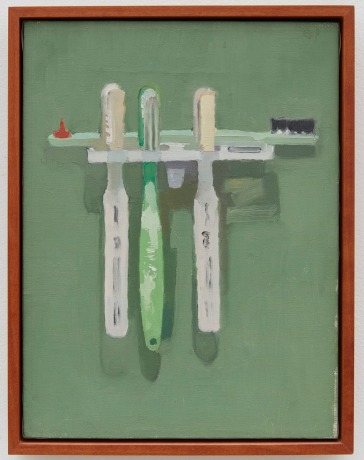
By Deborah Solomon
Nov. 16, 2022
Joe Brainard sought to take up as little space as possible. He specialized in small-scale works — collages, drawings, and occasional paintings that relate more to the proportions of a writer’s desk than an artist’s looming studio. “There is something I lack as a painter that de Kooning and Alex Katz have,” he jotted in his diary in 1967. “I wish I had that. I’d tell you what it was except that I don’t know.”
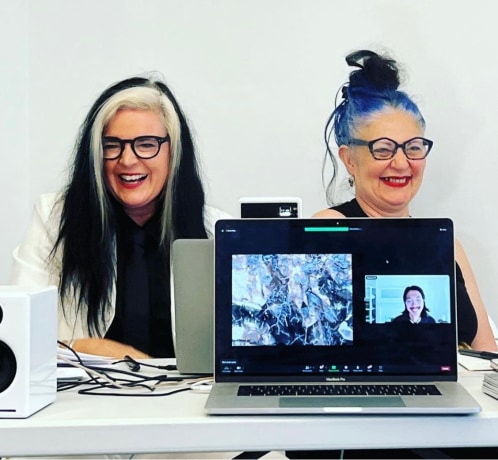
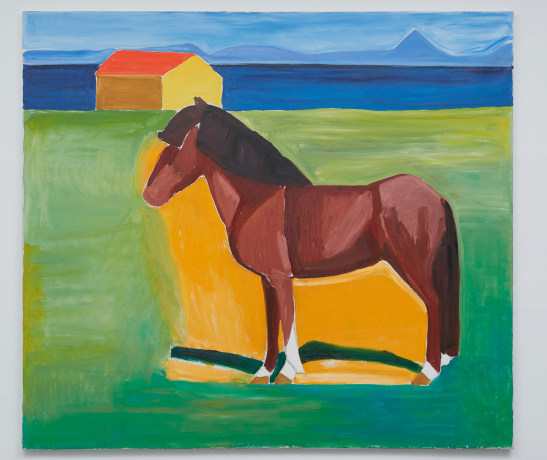
Born in Reykjavik, Iceland, in 1917, Louisa Matthiasdottir came to New York in 1942 and stayed, either in the city or upstate, until her death in 2000. Like her husband, Leland Bell, and other artists of their coterie, Matthiasdottir was a figurative painter, but one for whom the figure was as much a pretext for arranging blocks of color as an end in itself.
In “Hestar — Paintings in Iceland,” a strange and wonderful show at Tibor de Nagy, those color blocks are devoted to the stocky little horses (“hestar”) introduced to her native country by Nordic settlers. Rendered mostly in silhouette, without eyes, against glowing green heath and blue stripes of ocean and sky, these repeating figures might make you think of more recent conceptual painters like Ann Craven or Josh Smith. But Matthiasdottir’s compositions aren’t as simple as they look. A horse in a green field, with its bulky torso and narrow legs, is actually the perfect means of exploring the way solid objects distort our perception of their backgrounds. In “Black Horse With Pink Shirted Rider,” the animal’s feet are all level but the ground seems to rise, and change color, under its belly. The chestnut-colored equine in the glorious “Dark Horse, Yellow House, Red Roof I,” meanwhile, sheds golden light like an electric lamp. WILL HEINRICH
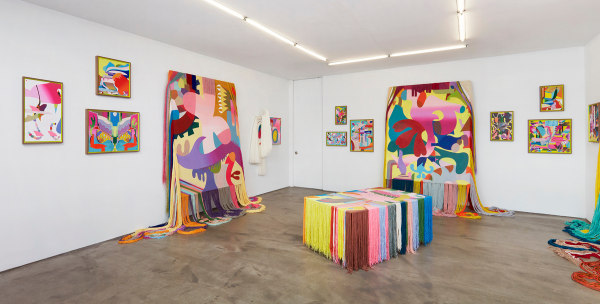
THERE ARE ARTISTS, THERE ARE ARTISTS’ collectives, and there is assume vivid astro focus. This entity (project? practice? platform? Its ontological status is purposely unclear) marks its twentieth anniversary this year, having been founded in New York City by Brazilian artist Eli Sudbrack. From the first, avaf was a radically open-ended endeavor. Even the name came by chance. “Astro” was occasioned by a case of mistaken identity in a secondhand clothing store; Sudbrack later discovered there was a makeup artist in the city by that name, who did in fact resemble him somewhat. He picked out the other words from “The LP Show,” a 2001 exhibition of more than 2,500 record covers curated by critic Carlo McCormick at Exit Art. Sudbrack collaged “Astro” with parts of the band name Ultra Vivid Scene and the title of Throbbing Gristle’s album Assume Power Focus.
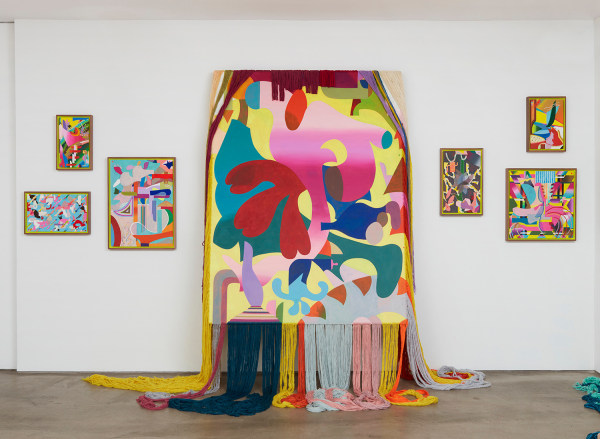
It’s been seven years since the duo known as Assume Vivid Astro Focus has had a show in New York. But this exuberant comeback effort, “Hairy What? Hairy How?” at Tibor de Nagy, is also a solo debut. Its four large semiabstract paintings and a painted table — all lavishly fringed with wool yarn and surrounded by numerous smaller unfringed pieces — are the work of the Brazilian artist Eli Sudbrack, one half of Assume Vivid Astro Focus. He formed it in New York in 2001 with Christophe Hamaide-Pierson, a French artist. These days the pair functions as much independently as together, but always under the collective’s name. This confuses, yet makes sense: Both sensibilities are rooted in the hallucinatory, multi-style, multimedia environments they concocted all over the globe for nearly two decades.
The extravagant fringe expands the paintings, flowing from all four sides to the floor, conjuring craft, fashion, dance, ritual objects and over-the-top interior decoration. The yarn always matches the infectious palette of the percolating compositions — a mix of Walt Disney, Magic Realism and South American abstraction that somehow glows with freshness. The shapes can be solid colors or graduated, fading to white as if on the silver (or computer) screen. The transitions of color and shape cause sudden pockets of space and cloudlike levitation. Elsewhere body parts are more than implied. The show recalls the sensory overload of Assume Vivid Astro Focus environments past. Compressed into this jewel-box space, the works read as a whole, especially through the gallery’s all-glass front.
ROBERTA SMITH
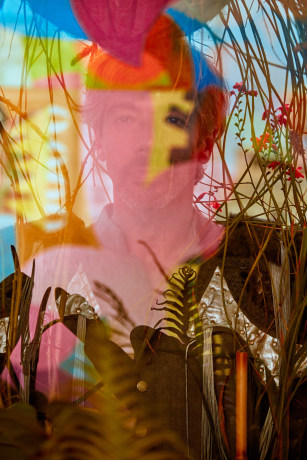
Eli Sudbrack in conversation with Michelle Jaffé
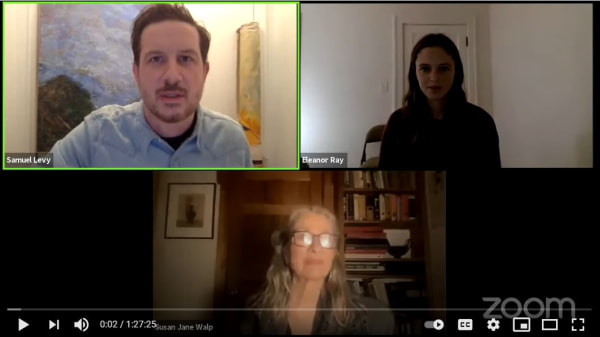
Susan Jane Walp in Conversation with Eleanor Rey, moderated by Samuel Levy
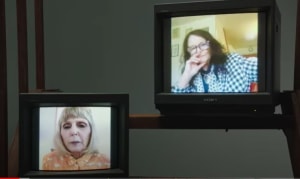
LOEWE | Joe Brainard: An Artist to Remember
Constance Lewallen and Anne Waldman on Joe Brainard on the occaison of the collaboration between the Estate of Joe Brainard and Jonathan Anderson, creative director of Loewe
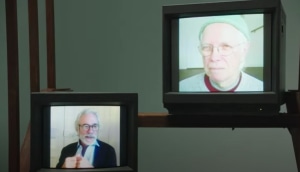
LOEWE | Joe Brainard: A Man to Remember
John Brainard and Ron Padgett discuss Joe Brainard on the occaision of the collaboration between the Estate of Joe Brainard and Jonathan Anderson, creative director of Loewe
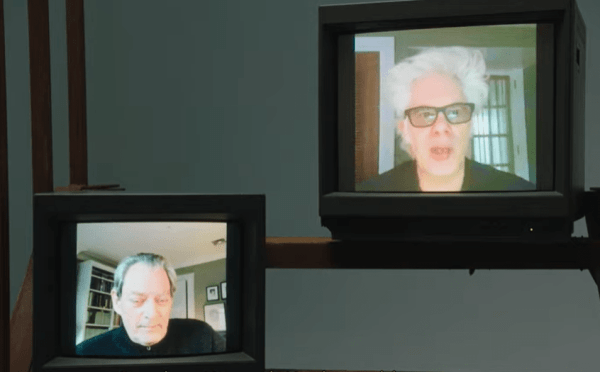
LOEWE | Joe Brainard: A Writer to Remember
Writer Paul Auster and film director Jim Jarmusch discuss the art and writing of Joe Brainard
done as part of a collaboration between the Estate of Joe Brainard and Jonathan Anderson, creative director of Loewe
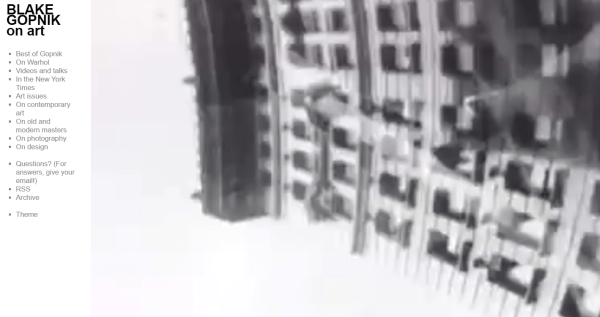
AT TIBOR DE NAGY, RUDY BURCKHARDT SHOWS US THE DEMOCRATIC JOYS OF A LOST MANHATTAN
THE DAILY PIC is one frame from Rudy Burckhardt’s 1975 film called “Default Averted,” now on view at Tibor de Nagy in New York, in a show that focuses on Burckhardt’s images and footage of New York in the 1970s and ‘80s.
Click link below to watch a clip from the 20-minute film, which does a lovely job of capturing a democratic energy that Manhattan has been losing for decades, as one percenters have taken it over.
I had forgotten just how many different kinds of people used to mix on the city’s streets, as I remember seeing on my first visit, back in 1980.
Having said which … I’m not sure that any other major city in North America or Europe can match the mixing that New York still delivers, to this day.
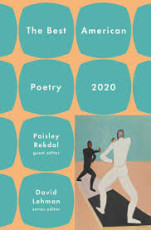
Rudy Burckhardt’s “New York Hello!” (part one) by Vincent Katz
Through January 23, run over to Tibor de Nagy Gallery at 11 Rivington Street to see a glorious selection of the later New York City street photographs of famed downtown denizen Rudy Burckhardt. You can also see the images online, but Burckhardt’s prints, small and unassuming as they are, repay close observation in person.
I guess the only art form that survives intact online is poetry. Poetry was something Burckhardt had a lot of, and I often find myself making the Freudian slip of referring to a photo of his as a “poem.” Partially, that has to do with the wide spaciousness Burckhardt was able to include in his photographs. They have a space in them that reminds one of the space in the city poems of his friends Edwin Denby, James Schuyler, and Frank O’Hara.
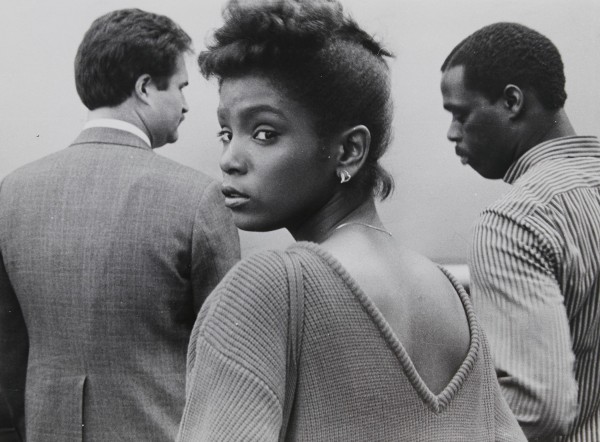
In a world where an artist is either a professional or an outsider, it is useful to consider these words by Rudy Burckhardt:
I am enough of an amateur existentialist and Buddhist to believe that we actually just mess around because we’re alive and awake — working, playing, scheming, falling apart, getting it together again, but never in control.
Burckhardt’s statement, which is cited in the press release for the exhibition Rudy Burckhardt: New York Hello! Photographs and Films from the 1970s and 1980s at Tibor de Nagy (December 11, 2020 – January 23, 2021), emphasizes his love for “mess[ing] around” rather than pursuing financial recompense in an industry where auction prices are often used to measure one’s accomplishments.
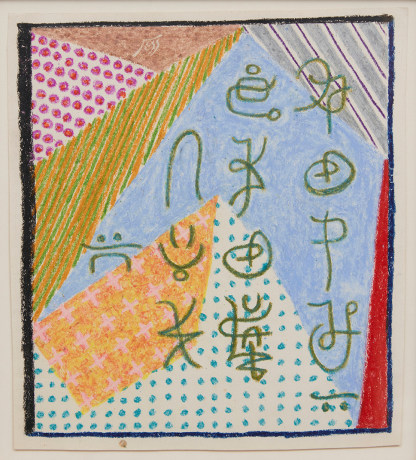
In 1974, the artist Jess (1923–2004) had an exhibition of oil paintings at the Museum of Modern Art in New York, curated by the institution’s legendary Kynaston McShine. The imagery and texts for the works were derived from a seemingly random variety of sources—including popular magazines, snapshots, and trading cards, along with quotations from Lewis Carroll, Thomas Hardy, Wassily Kandinsky, and Gertrude Stein, among many others. Accentuating the personal, evocative, and fantastical character of each piece, the poet Robert Duncan, Jess’s lifelong lover, emphasized that they were “related to the field of dream and magic.” Of the show, McShine wrote, “Jess’s paintings differ from most recent figurative work not only because of their literary connotations but also because their surfaces are so thickly impastoed with oil paints that the actual physicality of the paintings creates its own dialogue with the images.” This show featured thirteen early paintings and drawings, exploring what the artist called “the total network of color.” This chromatic system was clearly rooted in the artist’s feelings and fantasies, his myth of himself—or, more specifically, in that kaleidoscopic terrain known as the psyche.
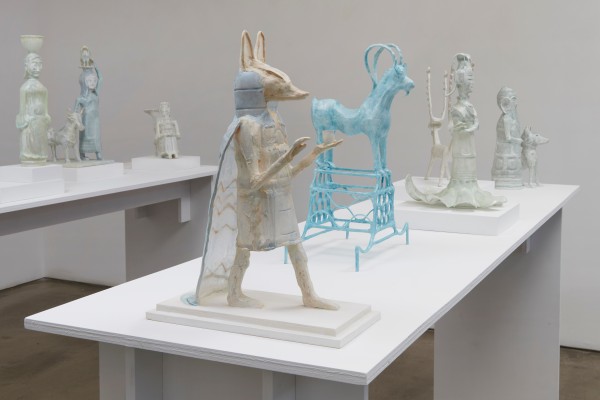
Shari Mendelson’s hauntingly beautiful sculptures—some part human, part animal, part divine—transport the viewer down the timeline into other worlds and dimensions. Their fragility and translucent luster are reminiscent of glass from antiquity and make us forget their humble origins. They are made from the discarded plastic bottles one associates with landfills and rubbish. To discuss them, we must excavate older concepts rubbished by a lot of critical theory such as animism, archetypes, numinosum, religious rituals, and the importance of votive and totemic objects.
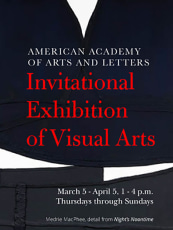
March 5 to April 5, 2020
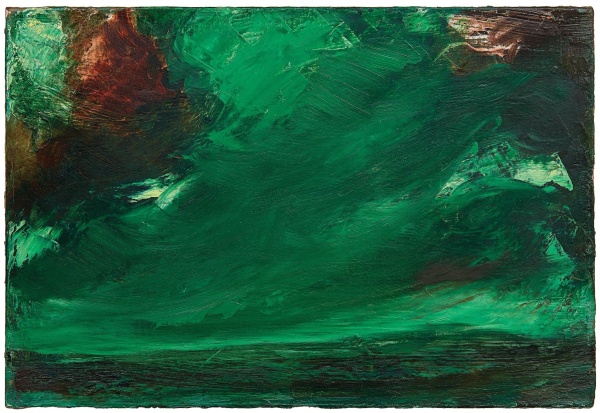
When he died of aids, at the age of forty-four, in 1993, the painter Jesse Murry left behind a number of canvases and works on paper in his New York studio that not only revealed a dreamy, lyrical talent but also hinted at the deeply detailed artist he would have become. In a small show at the Tibor de Nagy gallery (through Jan. 12), the artist’s beautiful color sense is on full display, as is his interest in abstraction as a kind of landscape filled with the splendor of the earth and the expansiveness of the sky. Murry’s works are not large in scale, but they promote big dreams: his terrain is the unfettered mind and eye. He draws you in with his liquid awareness of how paint works on canvas, and how color and form can and should be handled delicately, and with respect.
— Hilton Als
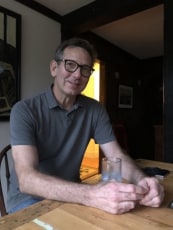
At the end of a rainy August day on Cape Cod, Richard Baker and I met at Edgewood Farm, a residency program at the Truro Center for the Arts at Castle Hill, where he was spending a week as a teacher in residence. I was attached to the idea that we would meet on the Cape; I associated Baker with the area, although he also lived in New York City for 25 years.
For many years, during the off-season, Baker used the studio at artist Pat de Groot’s house in Provincetown, and I would see his paintings lining the staircase wall, where she kept her collection of friends’ work. Baker later used a studio at my friend Sarah Lutz’s house in Truro, and he exhibits with Albert Merola Gallery in Provincetown. These traces of his presence assumed significance for me.
Our interview took a while to happen; life seemed to intervene several times, including Baker’s move from Brooklyn to Cambridge, which entailed contending with his significant collection of books — the subject of hundreds of his still life paintings.
The exhibition features Toebbe’s intricate works made with gouache, pencil and paper collage on wood panels. The images depict domestic interior settings pulled from the social media posts of the artist's friends and family in Ohio and Kentucky, as well as her own photos with her husband and children. Toebbe archived these social media posts from her large extended family, including 42 cousins, amassing a trove of images of family gatherings, birthday parties, baby showers, and displays of Christmas decorations. She uses the background details revealed in these postings to construct portraits of the homes themselves. One work, Friend: Sandie, is a widow’s home in Kentucky that is all frill draperies, doilies and Christmas ornaments; another, Friend: Becky shows a cousin’s sprawling house in southern Ohio, furnished with large furniture and even larger TV screens tuned to sports channels, like a specimen of American suburban life preserved in amber. Ann Toebbe answers our publishing director Atesh M. Gundogdu"s questionnaire.
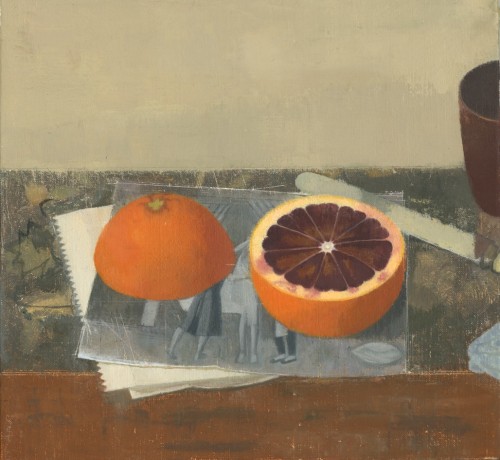
The impact of Susan Jane Walp’s still lifes defies their diminutive scale. In her paintings—fifteen of which were on view at Tibor de Nagy, all dimensions measuring less than eleven inches—she portrays domestic objects, patterned fabrics, and luscious fruit in rigorously balanced compositions whose rich, chalky tones suggest those of Roman frescoes. Born in Allentown, Pennsylvania, in 1949, Walp grew up immersed in Protestantism. The ordered painting approach she has been committed to for the past four decades reflects a tradition of American pragmatism that privileges discipline, attention, and craft. It also evinces a connection to painters such as Edwin Dickinson and Charles Hawthorne, who combined keen observation with an atmospheric, at times abstracted, sense of space.
One might describe Ashbery’s collage art as “a weird ether of forgotten dismemberments,” to borrow a line from his 1977 poem “Collective Dawns.”
John Ashbery, a Poet With Paper and Glue
A new book pairs some of Ashbery’s poems with the sophisticated and playful visual collages he also made over the course of his career.
By Gregory Cowles April 6, 2018
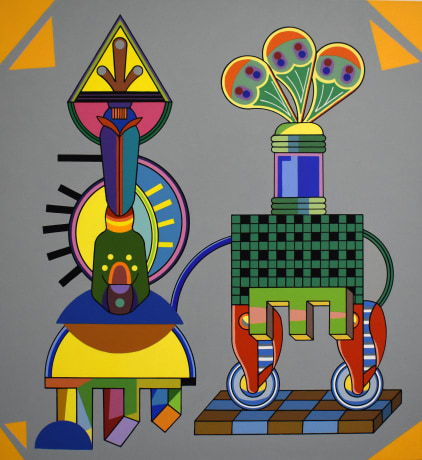
Born in Britain in 1944, Trevor Winkfield has lived in New York since 1969 and exhibited here almost as long. For decades, he has cultivated a style of Formalist Pop Surrealism that balances between fine and commercial art. His precedents include the proto-Pop paintings of Gerald Murphy; Paul Outerbridge’s advertising photography; and Picabia’s mechanical portraits which Mr. Winkfield might be said to have fleshed out.
While I was on my way to see his current exhibition, Trevor Winkfield – Saints, Dancers and Acrobats, at Tibor de Nagy Gallery (February 17 – March 25, 2018), I began to wonder — as someone who has followed his work since the late 1970s, and who has read many of the things written on his work, as well as much of his own writing — if I could add anything to what has already been said.
Winkfield begins with a collage, which is a hybrid of geometric forms and representational motifs rendered in solid colors. Whether the resulting image is a bird or an unidentifiable thingamajig, it is composed of outlined abstract shapes, which may be patterned or solidly colored. Over the years the artist has accumulated a vocabulary that ranges from heraldry to cartoony biomorphism, from crisp patterns to sly nods to artists he admires, such as Rene Magritte, Piet Mondrian and Kazimir Malevich. Along the way, he seems to have become an expert in vexillology, the study of flags.
PHILADELPHIA — The morning I began this review, my street was littered with used scratch-off lottery tickets from the local corner store. Some were stuck to tires; others were windblown against the gutter. One was smashed flat in the middle of the road. As I walked in one direction on the sidewalk, a guy walked towards me down the middle of the street. When he saw the smashed ticket, he picked it up, brushed it off, and slipped it in his pocket. There was both hope and anxiety in his gesture.
In this fast-paced reality, one which is rapidly blurring the lines that used to separate human biology and the 'human self' from technological advances, this artist’s creatures stand out not as an aberration but as a possible dystopic future.
In the paintings, figure-like apparitions congeal and dissolve as if governed by internal psychology or consciousness in the act of becoming. The DNA of these characters originates from blown glass—a material at once mercurial and fixed—with which Butler has worked extensively over the past 15 years.
“Mercurial and fixed,” “familiar albeit fantastical.” Paradoxical terms such as these came up repeatedly in conversations with painter Jim Butler as he discussed his new "Synaptic Reverb" series on view at New York's Tibor de Nagy Gallery through December 22, 2017.
Larry Rivers became an artist in the 1940s, and was soon part of a New York avant-garde scene of dancers, musicians and writers. A saxophonist-turned-painter, he refused to adhere to any genre, and his puckish work has an air of jazz improvisation. He’ll be celebrated at (RE)APPROPRIATIONS, an exhibition spanning five decades of his work at the Tibor de Nagy Gallery in New York from 6 September
Tibor de Nagy Gallery will be hosting an exhibition “(Re)appropriations” by artist Larry Rivers at the gallery’s new downtown location in New York.
"Using all of the inherent metaphors of language to visually suggest things like what is real and what is imaginary. What is the subplot? Is there transparency or opaqueness? Do these colors suggest something urgent/edgy or is the attitude more of stillness?" -Medrie MacPhee
"An extremely accomplished painter, MacPhee makes adjustments as she goes along — to her paintings; to her understanding of space; to the objects of her attention. "
- Stephen Maine
Weekly Standard contributor Lee Smith and friend to gallery artist Trevor Winkfield discuss paintings, writing and artist in two recent interviews.
"But her new work has an ingenious twist: the compositions combine oil paint and salvaged scraps of clothing. Buttons, seams, and the like remain intact, and the results have an irresistible weirdness."
This is Ms. MacPhee’s first exhibit with Tibor de Nagy and the simplified pictures here represent a change of course for the artist. In previous exhibitions she presented busy canvases, painting architectural renderings of construction site detritus.
THE DAILY PIC (#1814): MacPhee’s new body of work, with its collaged garment parts, is a big departure for her, and I think it succeeds.
Review of Medrie MacPhee's exhibition Scavenge at Tibor de Nagy Gallery's new Lower East Side location
Fabrics and paint combine into architectural forms in the work of this veteran artist who has lived in New York for more than 40 years.
Published 2017
Cloth over board | 20 pp
10 1/4" x 13"
Granary Books
Edition size: 30
Brand new moblie friendly artist website featuring extensive image gallery and biographical information.
John Newman makes drawings before, during and after his sculptures, many of them as ways to understand how to realize new ideas. Noted for his eccentric combinations of natural, manufactured, computer-generated and hand-crafted elements in his modestly-scaled sculptures, Newman likewise uses a variety of materials and techniques in his works on paper.
" For the next half-century, working in a small apartment-studio on the Left Bank, Ms. Jaffe refined and extended her inquiries into the drama of form and color — always at a distance, literally and figuratively, from the currents of American art."
-William Grimes
September 30, 2016
Susan and I talk about how she constructs her paintings, and how she balances precision with those spontaneous a-ha moments.
The War Years Collages are and old man's reflections on what he imagines he has experienced as we boy living at the New Jersey coast during World War II.
The new paintings on view act as mirrors, reflecting McEneaney’s core identity as an artist and activist and continuing her ongoing investigation of autobiography in her work.
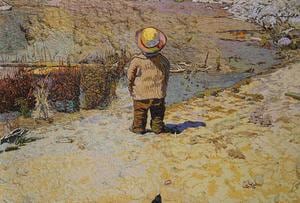
The Jess Collins Trust has now launch the official website for gallery artist Jess
Jane Levere covers the Parrish Art Museum's in her New York Times article The Divergent Styles of Jane Freilicher and Jane Wilson
Jen Mazza contributed an essay to Tilted Arc relating to her gallery exhibition " \ /\/\/\/\/\ /\\\\\\\\\///////////\ A PAINTING IS A MACHINE."
This exhibition brings together paintings and works on paper by Jane Freilicher and Jane Wilson—two notable figures in American art who emerged from the pursuit of rigorous abstraction to develop highly individual and beautifully compelling approaches to representation, fundamentally reinventing traditional definitions of landscape and still life painting.
Grey Art Gallery at NYU
Poetry Foundation and Valerie Carberry Gallery, Chicago
Figuring Color: Kathy Butterly, Felix Gonzalez-Torres, Roy McMakin, Sue Williams